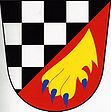Bezvěrov
| Bezvěrov | ||||
|---|---|---|---|---|
|
||||
| Basic data | ||||
| State : |
|
|||
| Region : | Plzeňský kraj | |||
| District : | Plzeň-sever | |||
| Area : | 4449 ha | |||
| Geographic location : | 50 ° 0 ' N , 13 ° 4' E | |||
| Height: | 675 m nm | |||
| Residents : | 651 (Jan. 1, 2019) | |||
| Postal code : | 330 40 - 330 41 | |||
| License plate : | P | |||
| traffic | ||||
| Street: | Úněšov - Toužim | |||
| structure | ||||
| Status: | local community | |||
| Districts: | 11 | |||
| administration | ||||
| Mayor : | Iveta Mašková (as of 2010) | |||
| Address: | Bezvěrov 101 330 41 Bezvěrov |
|||
| Municipality number: | 558656 | |||
| Website : | www.bezverov.cz | |||
Bezvěrov (German Bernklau ) is a municipality in the Czech Republic . It is located nine kilometers southeast of Toužim and belongs to the Okres Plzeň-sever .
geography
Bezvěrov is located on a saddle between the hills Bofort (715 m) and Zámecký vrch ( Pernglauberg ; 711 m) in the Tepler highlands . The Manětínský potok, the Krašovský potok and a tributary to the Úterský potok arise in Bezvěrov . State road 20 / E 49 between Úněšov and Toužim runs through the village .
Neighboring towns are Horni Luhov, Luhov, Komárov and Hradek in the north, Buc, Služetín and Bezverov in the northwest, Krašov and Kamenná Hora in the West, Chudeč and Čestětín the southeast, Dolní Jamné in the south, Nová Víska and Žernovník in the southwest, Ostřetín, Novy Dvur and Branišov in the west and Nežichov and Třebouň in the northwest.
history
The first written mention of Bernklau took place in 1379. The village Besmirov or Bezverovo , mentioned in a confirmation document of the Kladrau monastery in 1239 , cannot be precisely assigned, as all three villages that are now called Bezvěrov are eligible.
The existence of a fortress on Zámecký vrch has been documented since 1396, probably built by the brothers Linhart and Tůma from Kamennahora. Between 1502 and 1555 the festival was the seat of the Bärenklau family of Schönreuth, who renewed the festival around 1548. Subsequently there were frequent changes of ownership and the village belonged to the Kelner von Bärenklau, Theiner von Thein and the Zedtwitz auf Liebenstein . Nikolaus Ratschin von Ratschin had owned the goods since 1617. After the Battle of White Mountain in 1623 his property was confiscated and the Bärenklau rule with the villages of Krašov, Těšetín, Kamenná Hora, Vojtěšín, Račín and Tysová was sold to Wilhelm von Vřesovice. He sold the property in 1626 to the dukes of Saxony-Lauenburg on Theusing , who connected Bernklau to the Pürles estate. In 1837 Alfred Beaufort-Spontini acquired the goods in Bernklau.
After the abolition of patrimonial Bernklau / Bezvěrov formed a municipality in the Kralowitz district from 1850 . In 1867, Eduard Kavalier from Sázava founded the Nová Sázava glassworks , which produced crystal glass. It was shut down in 1923. In 1930 there were 637 people in Bernklau. After the Munich Agreement , the municipality was annexed to the German Reich in 1938 and belonged to the Luditz district until 1945 . In 1939 the community had 578 inhabitants. After the end of World War II, Bezvěrov came back to Czechoslovakia and the German residents were expelled . Between 1949 and 1960 the community belonged to the Okres Toužim. Since January 1st 1961 it has been part of the Okres Plzeň-sever . At the same time Krašov and Vlkošov (with Potok) were incorporated. In 1976 Dolní Jamné (with Chudeč, Nová Víska, Očehora, Račín I. and II. Share and Světec) and Služetín (with Buč) were incorporated.
Local division
The municipality of Bezvěrov consists of the districts Bezvěrov ( Bernklau ), Buč ( Pusch ), Chudeč ( Kutsch ), Dolný Jamny ( Unter Jamny ), Krašov ( Krasch ), Nová Víska ( Neudörfel ), Potok, Služetín ( Lusetin ), Světec ( Schwitz ), Vlkošov ( Wilkischau ) and Žernovník ( Schirnik ) as well as the settlements Hrádek ( glassworks ), Na Hrádku ( castles ), Nová Sázava ( New Sazawa ), Ostřetín ( desert ) and Račín ( Ratschin ). Bezvěrov also includes the corridors of the extinct settlement of Očehora ( Ranitzenhäuseln or Hotschehora ).
Attractions
- historical sandstone boundary stones between the dominions Theusing and Pürles from 1623
- Chapel of St. Florian, built in the second half of the 19th century
- former Kavalier glassworks, technical monument
- Cast iron crucifix on the road to Manětín from 1886
- Ruins of the Church of St. Blaise near Branišov
- Festivities Na Hrádku
- Parish church in Krašov
- East of the municipality is the Krašov transmitter, the second highest building in the Czech Republic.

